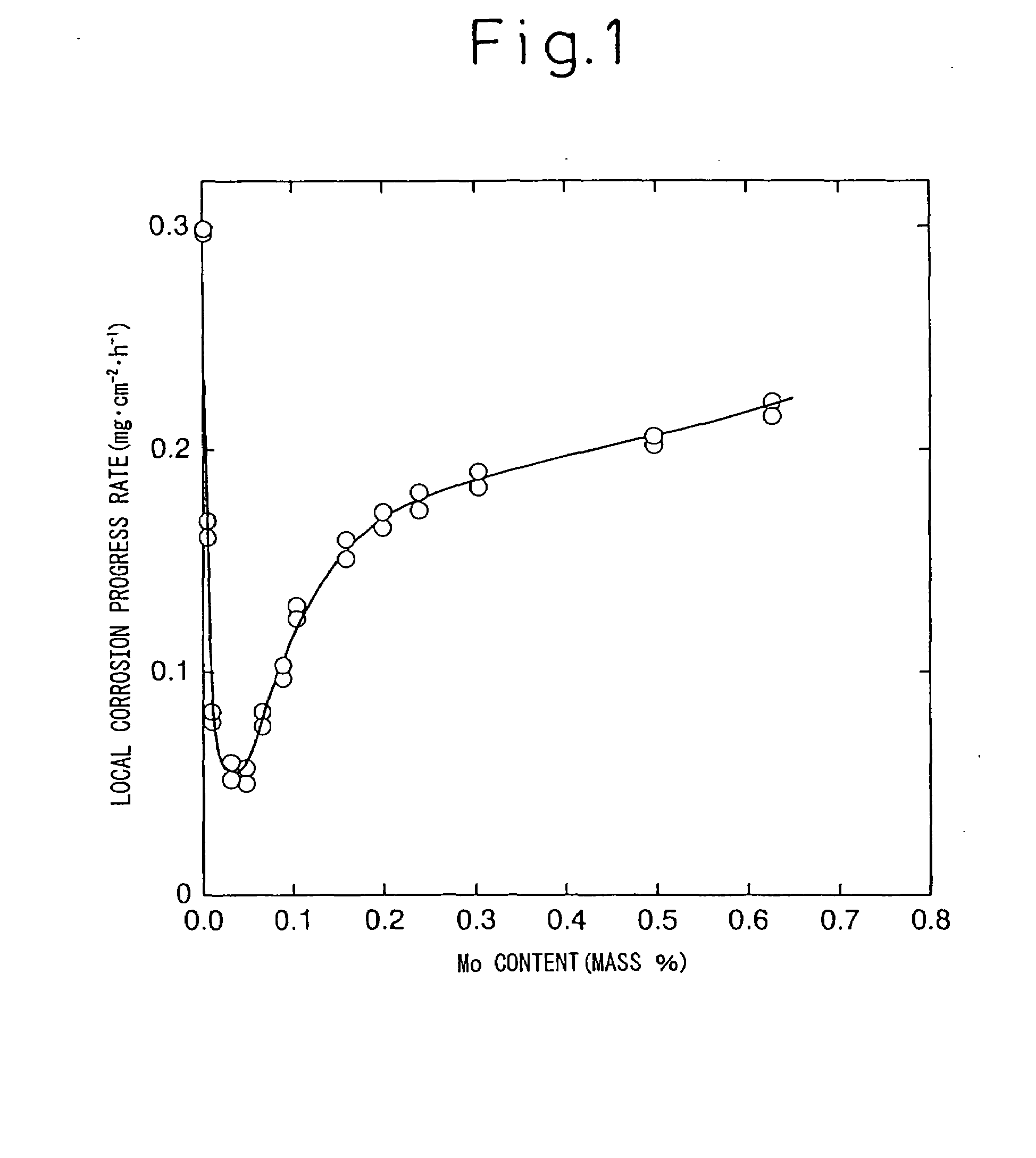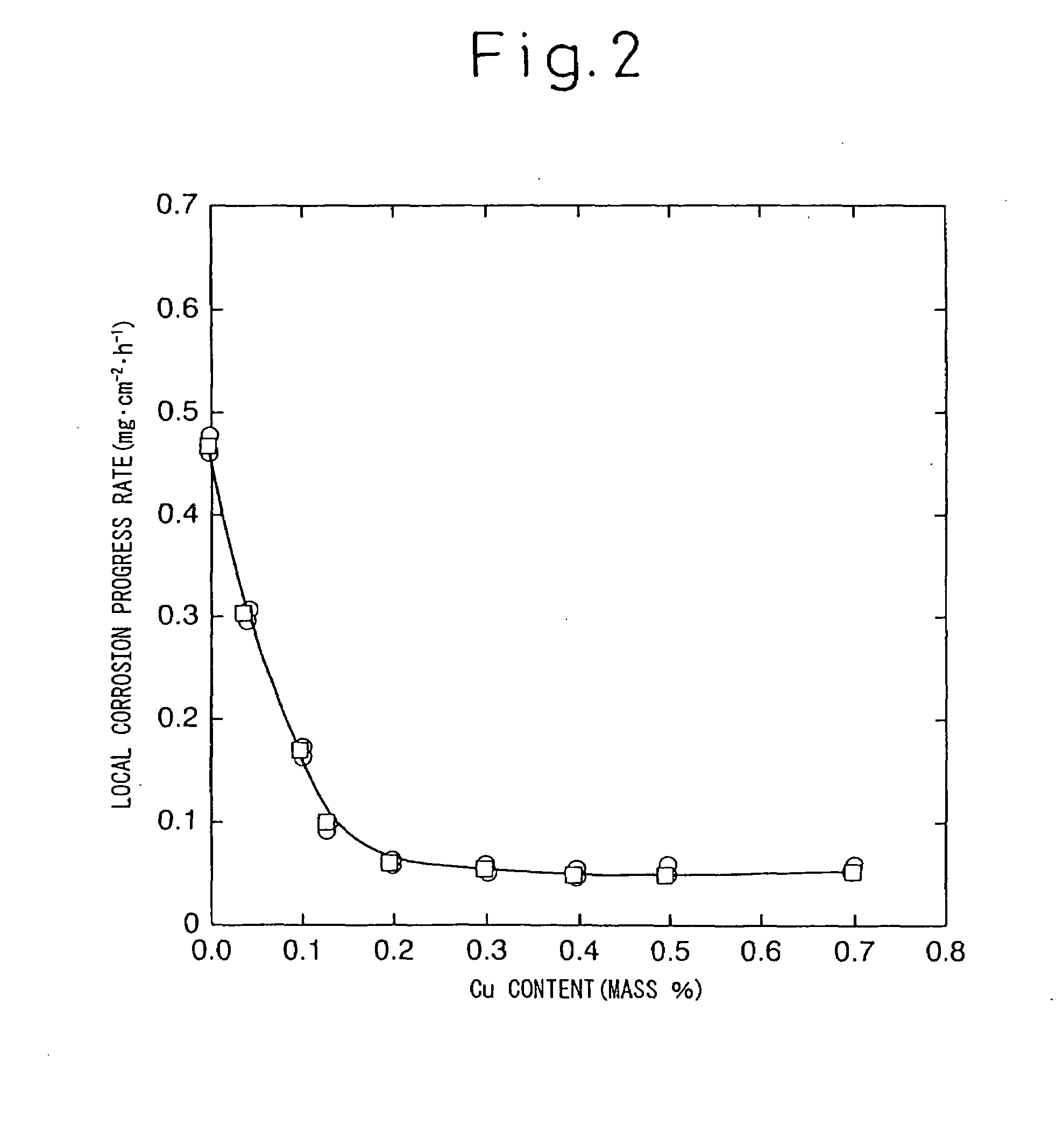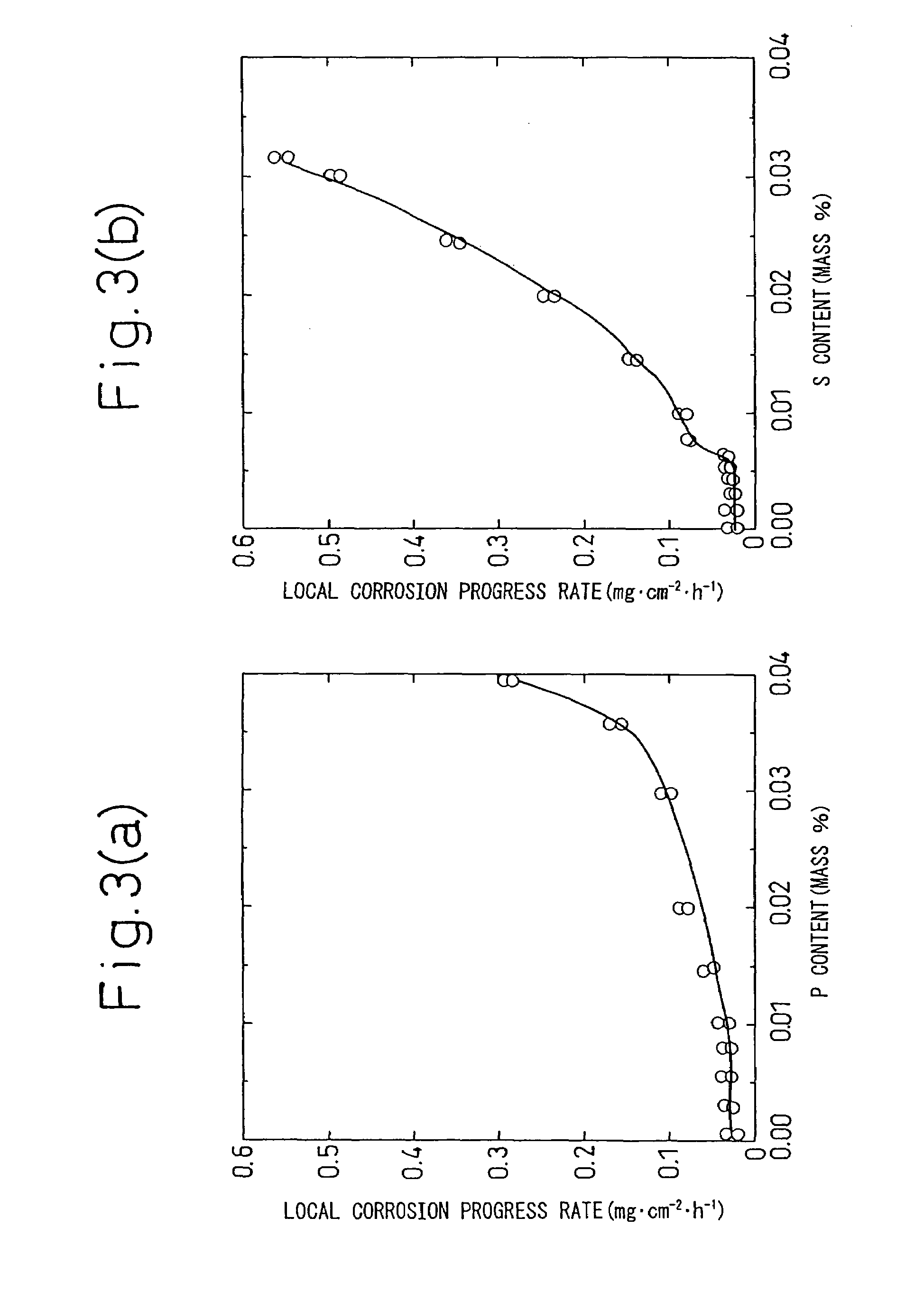In such an environment, a steel is damaged by general corrosion and local corrosion in the form of pitting.
The local corrosion of structural members of a crude oil tank is particularly detrimental, because when corrosion progresses locally, loads on the corroded portions increase beyond what is expected in the design, and
large strain and / or plastic deformation occur(s), leading to possible destruction of the whole structure.
In addition, it is difficult to predict the location of local corrosion and its rate of progress.
In addition to the corrosion damage mentioned above, a large quantity of solid sulfur forms and precipitates on the internal surface of a steel oil tank, especially on the reverse side surface of a steel plate of an upper
deck (
deck plate).
Since a solid sulfur layer is brittle, the corrosion product composed of iron
rust and solid sulfur easily exfoliates, falls off and accumulates as sludge at the bottom of an oil tank.
However, in addition to the economical problems of the time and costs involved in re-painting the reverse side of all the
deck plates of a very large crude oil carrier, there has also been a technical problem in that protection by painting and / or lining also requires periodical inspections and repair, because corrosion inevitably progresses as a result of microscopic defects caused during the application of protective
layers and age-related degradation.
Despite the above, no technology to suppress the
precipitation of solid sulfur on a steel plate surface by improving the corrosion resistance of the steel plate itself in a crude oil tank environment has been disclosed.
The problems arising when corrosion is mitigated by means of
corrosion prevention coating such as primer
coating, heavy-duty
coating or
metal spraying have been that: the application work entails substantial costs; and, in addition, corrosion develops to a extent comparable to a case of bare use in 5 to 10 years of normal use at the longest, because local corrosion inevitably occurs and propagates from microscopic defects in protective coating
layers caused during the application work and other defects resulting from age-related degradation.
Another problem has been that periodical inspections and repair are indispensable and maintenance costs are involved as a consequence.
Yet another problem has been that, with regard to local corrosion at the
floor plate of an oil tank, the rate of progress of local corrosion occurring after protective coating
layers have been degraded is substantially the same as that occurring in bare use.
S50-158515 have been that: since it contains Cr, which is detrimental to corrosion resistance in a crude oil tank environment, in excess of 0.1%, the rate of progress of local corrosion at the
floor plate of an oil tank is not reduced and the cost effect of corrosion resistance is insufficient to justify the total addition amount of the alloying elements; and the
weldability of the steel is poor in comparison with an ordinary steel because it contains Cr.
The problems of the corrosion-resistant steel for shipbuilding disclosed in Japanese Unexamined Patent Publication No. 2000-17381 have been that: since it contains Mg as an indispensable element, the production of the steel is unstable; and, according to the studies by the present inventors, the rate of progress of local corrosion at the
floor plate of an oil tank is not reduced by the use of a Cu—Mg steel and the cost effect of corrosion resistance is insufficient to justify the total addition amount of the alloying elements.
The problems of the corrosion-resistant steel for an oil loading tank (a high-P—Cu—Ni—Cr-high-Al steel) disclosed in Japanese Unexamined Patent Publication No. 2001-107179 have been that: since it contains Cr, which is detrimental to corrosion resistance in an environment of a crude oil tank floor plate, by 0.3 to 4% in excess of 0.1%, the rate of progress of local corrosion at the floor plate of an oil tank is not reduced and the cost effect of corrosion resistance is insufficient to justify the total addition amount of the alloying elements; and the
weldability of the steel is poor in comparison with an ordinary steel because it contains Cr.
The problems of the corrosion-resistant steel for an oil loading tank (a low-P—Cu—Ni—Cr-high-Al steel) disclosed in Japanese Unexamined Patent Publication No. 2001-107180 have been that: since it contains Cr, which is detrimental to corrosion resistance in an environment of a crude oil tank floor plate, by 0.3 to 4% in excess of 0.1%, the rate of progress of local corrosion at the floor plate of an oil tank is not reduced and the cost effect of corrosion resistance is insufficient to justify the total addition amount of the alloying elements; the weldability of the steel is poor in comparison with an ordinary steel because it contains Cr; and, although the publication maintains that the steel after application of a primer coating suppresses corrosion under a coating film in a
gas phase to which the reverse side of a deck plate or the like of an oil tank is exposed, since the steel contains comparatively large amounts of Cr and Al, the rate of corrosion propagating in the thickness direction from defects in a coating film is not reduced despite the width of
blisters occurring from defects in the coating film being reduced.
The problem of the corrosion-resistant steels (Cu—Ni steels) for oil loading tanks disclosed in Japanese Unexamined Patent Publication Nos. 2002-12940 and 2003-105467 has been that, though the publications maintain that Cu and Ni are effective in enhancing corrosion resistance, more specifically resistance to corrosion under a coating film, and Mo is detrimental to corrosion resistance but is effective for enhancing strength, since any of the Cu—Ni—Mo steels proposed as corrosion-resistant steels in the example contains Mo in excess of the upper limit (0.2%) of the present invention, the effect of suppressing the progress of local corrosion at the floor plate of a crude oil tank is not achieved.
The problems of the corrosion-resistant steel for a tank for transporting or storing crude oil (a Cu—Ni—Cr steel) disclosed in Japanese Unexamined Patent Publication No. 2002-173736 have been that: the steel contains 0.5 to 1.5% Cu, 0.5 to 3.0% Ni and 0.5 to 2.0% Cr as basic components, thus large amounts of alloying elements must be added for the effect to appear; thus the economical efficiency and weldability of the proposed steels are poor; and further, since the steel contains Cr, which is detrimental to corrosion resistance in an environment of a crude oil tank floor plate, in excess of 0.1%, the rate of progress of local corrosion at the floor plate of an oil tank is not reduced and the cost effect of corrosion resistance is insufficient to justify the total addition amount of the alloying elements.
The problems of the steels have been that: all of these steels requires relatively large addition amounts of alloying components even though only the basic components are taken into consideration and results in unfavorable costs and weldability; and further, in order to realize excellent corrosion resistance in an environment of a crude oil tank floor plate, it is necessary to use an Ni-contained steel or a Cu—Ni steel, control the number of inclusions larger than 30 μm in grain size to less than 30 / cm2, and control the
pearlite ratio Ap in the metallographic structure and the carbon content in the steel so as to satisfy the expression Ap / C≦130.
The problems of the corrosion-resistant low-
alloy steel disclosed in Japanese Unexamined Patent Publication No.
The problems of the Cu—Mo steel proposed in Japanese Unexamined Patent Publication No.
The problem of the corrosion-resistant steels disclosed in Japanese Unexamined Patent Publication Nos.
Automobile undercarriage members suffer wet corrosion involving
chloride ions with deicing salt attaching thereto.
In the case of those steels for automobile undercarriage parts excellent in
pitting corrosion resistance and other weatherproof steels, although it is true that a protective dense
rust layer forms on the surface even when such a steel is used in a salt damage environment, such excellent
pitting corrosion resistance is obtained only in an environment where wet and dry are repeated properly and resultantly a protective dense
rust layer forms spontaneously and not in an environment where the steel surface is always wet.
Thus, such excellent
pitting corrosion resistance is not obtained in an environment where the time of
wetting is long or the steel surface is always wet.
On the other hand, in the case of the
seawater-resistant low-
alloy steels mentioned above, though they often exhibit better performance than ordinary steels regarding the kind of corrosion resistance to be evaluated in terms of an average thickness
loss rate, they are not viewed as distinctly superior to ordinary steels regarding a local corrosion rate of progress (cf.
However, like in the case of corrosion reduction measures, the problems of the technologies have been that: the application work entails economic costs; and, in addition, since corrosion inevitably progresses as a result of microscopic defects in protective layers caused during the application work and age-related degradation, periodical inspections and repair are indispensable and the service life is limited to 5 to 10 years, even when painting and lining are applied.
Despite the above problems, there has been disclosed no technology to decrease the
precipitation of solid sulfur on a steel surface by improving the corrosion resistance of steel itself in a crude oil tank environment.
 Login to View More
Login to View More 


